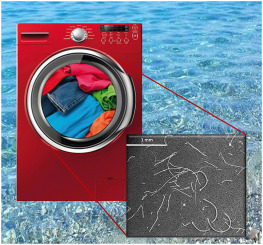Environmental Pollution ( IF 7.6 ) Pub Date : 2017-10-27 , DOI: 10.1016/j.envpol.2017.10.057 Francesca De Falco , Maria Pia Gullo , Gennaro Gentile , Emilia Di Pace , Mariacristina Cocca , Laura Gelabert , Marolda Brouta-Agnésa , Angels Rovira , Rosa Escudero , Raquel Villalba , Raffaella Mossotti , Alessio Montarsolo , Sara Gavignano , Claudio Tonin , Maurizio Avella

|
A new and more alarming source of marine contamination has been recently identified in micro and nanosized plastic fragments. Microplastics are difficult to see with the naked eye and to biodegrade in marine environment, representing a problem since they can be ingested by plankton or other marine organisms, potentially entering the food web. An important source of microplastics appears to be through sewage contaminated by synthetic fibres from washing clothes. Since this phenomenon still lacks of a comprehensive analysis, the objective of this contribution was to investigate the role of washing processes of synthetic textiles on microplastic release. In particular, an analytical protocol was set up, based on the filtration of the washing water of synthetic fabrics and on the analysis of the filters by scanning electron microscopy. The quantification of the microfibre shedding from three different synthetic fabric types, woven polyester, knitted polyester, and woven polypropylene, during washing trials simulating domestic conditions, was achieved and statistically analysed. The highest release of microplastics was recorded for the wash of woven polyester and this phenomenon was correlated to the fabric characteristics. Moreover, the extent of microfibre release from woven polyester fabrics due to different detergents, washing parameters and industrial washes was evaluated. The number of microfibres released from a typical 5 kg wash load of polyester fabrics was estimated to be over 6,000,000 depending on the type of detergent used. The usage of a softener during washes reduces the number of microfibres released of more than 35%. The amount and size of the released microfibres confirm that they could not be totally retained by wastewater treatments plants, and potentially affect the aquatic environment.
中文翻译:

评价合成纤维织物的洗涤过程引起的微塑料释放
最近,在微米和纳米尺寸的塑料碎片中发现了一种新的,更令人震惊的海洋污染源。微塑料很难用肉眼看到,并且很难在海洋环境中生物降解,这是一个问题,因为浮游生物或其他海洋生物可能会将其摄入,从而有可能进入食物网。微量塑料的重要来源似乎是来自被洗衣服中的合成纤维污染的污水。由于这种现象仍缺乏全面的分析,因此该研究的目的是研究合成纺织品的洗涤过程对微塑料释放的作用。特别地,基于合成织物的洗涤水的过滤以及通过扫描电子显微镜对过滤器的分析,建立了分析方案。在模拟家庭条件的洗涤试验中,对三种不同的合成纤维类型(机织聚酯,针织聚酯和机织聚丙烯)的微纤维脱落进行了量化,并进行了统计分析。记录了机织聚酯洗涤过程中微塑料的最高释放,这种现象与织物特性有关。此外,评价了由于不同的洗涤剂,洗涤参数和工业洗涤而从机织聚酯织物释放的微纤维的程度。由典型的5公斤涤纶织物洗涤负荷释放的微纤维数量估计超过6,000,000,具体取决于所用洗涤剂的类型。在洗涤过程中使用软化剂可使释放的微纤维数量减少35%以上。











































 京公网安备 11010802027423号
京公网安备 11010802027423号